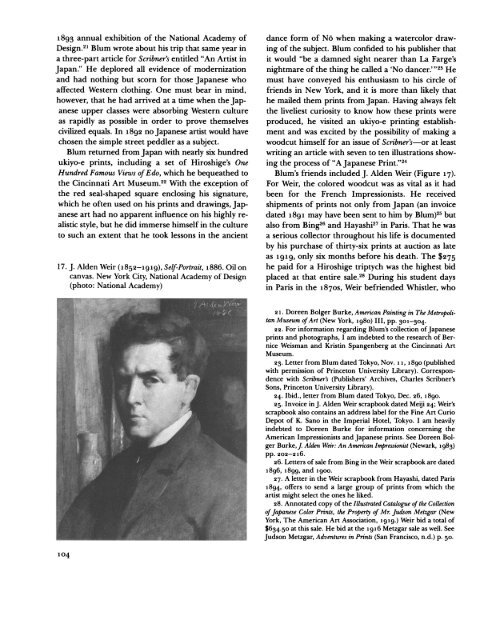Early Collectors of Japanese Prints and The Metropolitan Museulm ...
Early Collectors of Japanese Prints and The Metropolitan Museulm ...
Early Collectors of Japanese Prints and The Metropolitan Museulm ...
Create successful ePaper yourself
Turn your PDF publications into a flip-book with our unique Google optimized e-Paper software.
1893 annual exhibition <strong>of</strong> the National Academy <strong>of</strong><br />
Design.21 Blum wrote about his trip that same year in<br />
a three-part article for Scribner's entitled "An Artist in<br />
Japan." He deplored all evidence <strong>of</strong> modernization<br />
<strong>and</strong> had nothing but scorn for those <strong>Japanese</strong> who<br />
affected Western clothing. One must bear in mind,<br />
however, that he had arrived at a time when the <strong>Japanese</strong><br />
upper classes were absorbing Western culture<br />
as rapidly as possible in order to prove themselves<br />
civilized equals. In 1892 no <strong>Japanese</strong> artist would have<br />
chosen the simple street peddler as a subject.<br />
Blum returned from Japan with nearly six hundred<br />
ukiyo-e prints, including a set <strong>of</strong> Hiroshige's One<br />
Hundred Famous Views <strong>of</strong> Edo, which he bequeathed to<br />
the Cincinnati Art Museum.22 With the exception <strong>of</strong><br />
the red seal-shaped square enclosing his signature,<br />
which he <strong>of</strong>ten used on his prints <strong>and</strong> drawings, <strong>Japanese</strong><br />
art had no apparent influence on his highly realistic<br />
style, but he did immerse himself in the culture<br />
to such an extent that he took lessons in the ancient<br />
17. J. Alden Weir (1852-1919), Self-Portrait, 1886. Oil on<br />
canvas. New York City, National Academy <strong>of</strong> Design<br />
(photo: National Academy)<br />
104<br />
''' '"''''~~~~~~x-<br />
dance form <strong>of</strong> No when making a watercolor drawing<br />
<strong>of</strong> the subject. Blum confided to his publisher that<br />
it would "be a damned sight nearer than La Farge's<br />
nightmare <strong>of</strong> the thing he called a 'No dancer.'"23 He<br />
must have conveyed his enthusiasm to his circle <strong>of</strong><br />
friends in New York, <strong>and</strong> it is more than likely that<br />
he mailed them prints from Japan. Having always felt<br />
the liveliest curiosity to know how these prints were<br />
produced, he visited an ukiyo-e printing establishment<br />
<strong>and</strong> was excited by the possibility <strong>of</strong> making a<br />
woodcut himself for an issue <strong>of</strong> Scribner's-or at least<br />
writing an article with seven to ten illustrations showing<br />
the process <strong>of</strong> "A <strong>Japanese</strong> Print."24<br />
Blum's friends included J. Alden Weir (Figure 17).<br />
For Weir, the colored woodcut was as vital as it had<br />
been for the French Impressionists. He received<br />
shipments <strong>of</strong> prints not only from Japan (an invoice<br />
dated 1891 may have been sent to him by Blum)25 but<br />
also from Bing26 <strong>and</strong> Hayashi27 in Paris. That he was<br />
a serious collector throughout his life is documented<br />
by his purchase <strong>of</strong> thirty-six prints at auction as late<br />
as 9199, only six months before his death. <strong>The</strong> $275<br />
he paid for a Hiroshige triptych was the highest bid<br />
placed at that entire sale.28 During his student days<br />
in Paris in the 187os, Weir befriended Whistler, who<br />
21. Doreen Bolger Burke, American Painting in <strong>The</strong> Metropoli-<br />
tan Museum <strong>of</strong> Art (New York, 1980) III, pp. 301-304.<br />
22. For information regarding Blum's collection <strong>of</strong> <strong>Japanese</strong><br />
prints <strong>and</strong> photographs, I am indebted to the research <strong>of</strong> Ber-<br />
nice Weisman <strong>and</strong> Kristin Spangenberg at the Cincinnati Art<br />
Museum.<br />
23. Letter from Blum dated Tokyo, Nov. 11, 1890 (published<br />
with permission <strong>of</strong> Princeton University Library). Correspondence<br />
with Scribner's (Publishers' Archives, Charles Scribner's<br />
Sons, Princeton University Library).<br />
24. Ibid., letter from Blum dated Tokyo, Dec. 26, 1890.<br />
25. Invoice inJ. Alden Weir scrapbook dated Meiji 24; Weir's<br />
scrapbook also contains an address label for the Fine Art Curio<br />
Depot <strong>of</strong> K. Sano in the Imperial Hotel, Tokyo. I am heavily<br />
indebted to Doreen Burke for information concerning the<br />
American Impressionists <strong>and</strong> <strong>Japanese</strong> prints. See Doreen Bolger<br />
Burke,J. Alden Weir: An American Impressionist (Newark, 1983)<br />
pp. 202-216.<br />
26. Letters <strong>of</strong> sale from Bing in the Weir scrapbook are dated<br />
1896, 1899, <strong>and</strong> 1900.<br />
27. A letter in the Weir scrapbook from Hayashi, dated Paris<br />
1894, <strong>of</strong>fers to send a large group <strong>of</strong> prints from which the<br />
artist might select the ones he liked.<br />
28. Annotated copy <strong>of</strong> the Illustrated Catalogue <strong>of</strong> the Collection<br />
<strong>of</strong> <strong>Japanese</strong> Color <strong>Prints</strong>, the Property <strong>of</strong> Mr. Judson Metzgar (New<br />
York, <strong>The</strong> American Art Association, 1919.) Weir bid a total <strong>of</strong><br />
$634.50 at this sale. He bid at the 1916 Metzgar sale as well. See<br />
Judson Metzgar, Adventures in <strong>Prints</strong> (San Francisco, n.d.) p. 50.

















